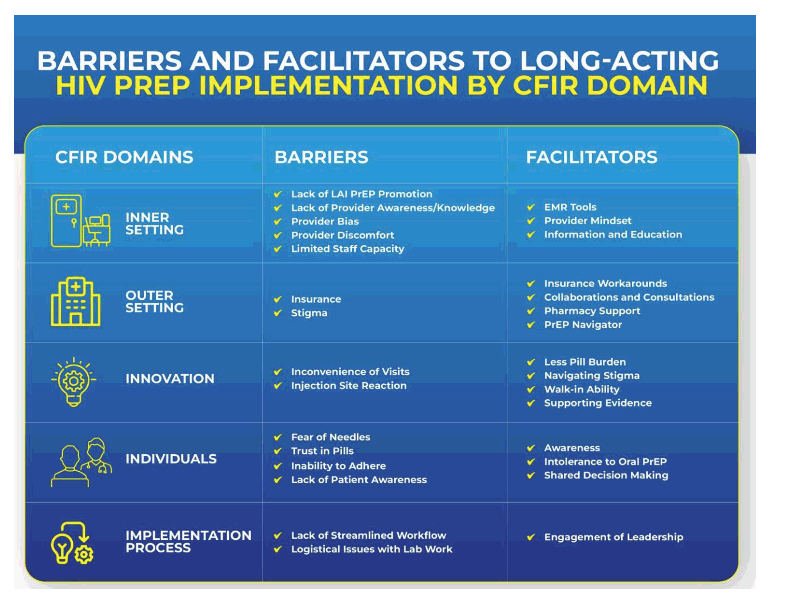| |
LAI PrEP Barriers & Facilitators US Primary Care Setting
|
| |
| |
Download the PDF here
JAIDS December 22, 2023

Discussions
This qualitative study used the CFIR framework to describe the early rollout of LAI PrEP in a Family Medicine setting. Overall, stakeholders described a very low uptake of LAI PrEP. Barriers to LAI PrEP implementation included a lack of awareness, insurance and access issues, a lack of streamlined workflow, and a trust in pills over injectables. Facilitators to LAI PrEP implementation included the absence of a pill burden, a culture of shared decision making, and pharmacy support.
The low uptake of LAI PrEP and barriers to its implementation were consistent with barriers to uptake of PrEP overall. We identified the same knowledge and awareness gaps seen in oral PrEP implementation. Distrust in new medical technologies overall was linked to a distrust in the healthcare system, reflecting another major barrier to PrEP15, 16. This distrust likely stems from mistreatment of marginalized populations, including people with HIV, substance use disorders, and those in sexual, racial or gender minoritized groups.16 Our interviews corroborated this distrust as patients described perceived discrimination and stigma surrounding provider discussions around HIV risk and prevention.
We also identified access barriers to LAI PrEP, including adhering to bi-monthly visits and lab work and persevering through insurance workarounds. Such barriers may be insurmountable for marginalized populations vulnerable to HIV.
We noted a lack of awareness and confidence among providers in prescribing LAI PrEP. There is a need for programs to train and inform providers about all PrEP modalities to increase comfort among providers and to normalize patient-provider discussions about PrEP and HIV risk. PrEP navigators, an important system-wide resource in this setting, were instrumental in supporting PrEP prescribing. PrEP navigators can bridge the communication gap between patients and providers and address issues of trust17, 18, especially among marginalized groups of patients19. Dedicated personnel or personnel skilled at navigating insurance workflows to access LAI PrEP, such as pharmacy staff, was noted to be crucial for LAI PrEP uptake. Clinics and/or health systems should consider incorporating these roles into their practices to ensure access to LAI PrEP. Additionally, as described by our participants, healthcare settings can benefit from harnessing the power of EMR for LAI PrEP care to streamline workflow issues for patients and providers.
Pharmacists in our study were one of the critical facilitators to the rollout and implementation of LAI PrEP. Given their expertise in medication monitoring, safety, and interactions and their training in patient counseling, pharmacists are well-positioned to manage HIV PrEP. As a discipline, pharmacists have some of the highest levels of PrEP awareness and knowledge as compared with medical and nursing providers.20 Pharmacist-led HIV PrEP programs have been described in various settings including federally qualified health centers21, non-clinical settings22, university-based HIV and primary care clinics23, and the Veterans Health Administration24. In some states, through a collaborative practice agreement25, pharmacist can operate under a physician's or other license practitioner's oversight, allowing a pharmacist to take on specific patient care responsibilities. During our study, a collaborative practice agreement was initiated in the Family Medicine setting at our institution to streamline processes and free up PCP's time.
Both patients and providers described a patient-centered approach to HIV prevention. Such an approach emphasizes the autonomy of the patient in an environment that fosters mutual trust and respect that centers around patients meeting their HIV prevention needs and social goals.26 As the context of their own preferences and desires to foster trust with patients and empower them to engage in PrEP care.
Setting:
A Family Medicine practice in a single health organization in the United States (November 2022 - February 2023)
Study participants were recruited from a Family Medicine practice at an academic medical center in Philadelphia. Participants included practice stakeholders and patients. Practice stakeholders were identified by program implementers and invited to participate by email. Implementers were individuals who were involved with the design, rollout, and implementation of LAI PrEP.
Methods:
We conducted interviews with patients and key stakeholders to characterize factors affecting LAI PrEP implementation. Data collection and analysis were guided by the Consolidated Framework for Implementation Research. Interviews were transcribed and analyzed using guided content analysis.
Results:
Twenty-five patients (n=13) and practice stakeholders (n=12) were interviewed. Overall, stakeholders described a very low uptake of LAI PrEP. Barriers to LAI PrEP included a lack of awareness, insurance and access issues, a lack of streamlined workflow, and a trust in pills over injectables. Facilitators to LAI PrEP implementation included the absence of a pill burden, a culture of shared decision making, and pharmacy support.
Conclusion:
While uptake has been slow, we have identified several promising strategies for improving rollout and implementation of LAI PrEP. Approaches that can bolster rollout of LAI PrEP include having an interdisciplinary care team that is supported by PrEP navigators and pharmacists and are informed by a patient-centered model of care to increase patient engagement and trust.
|
|
| |
| |
|
|
|